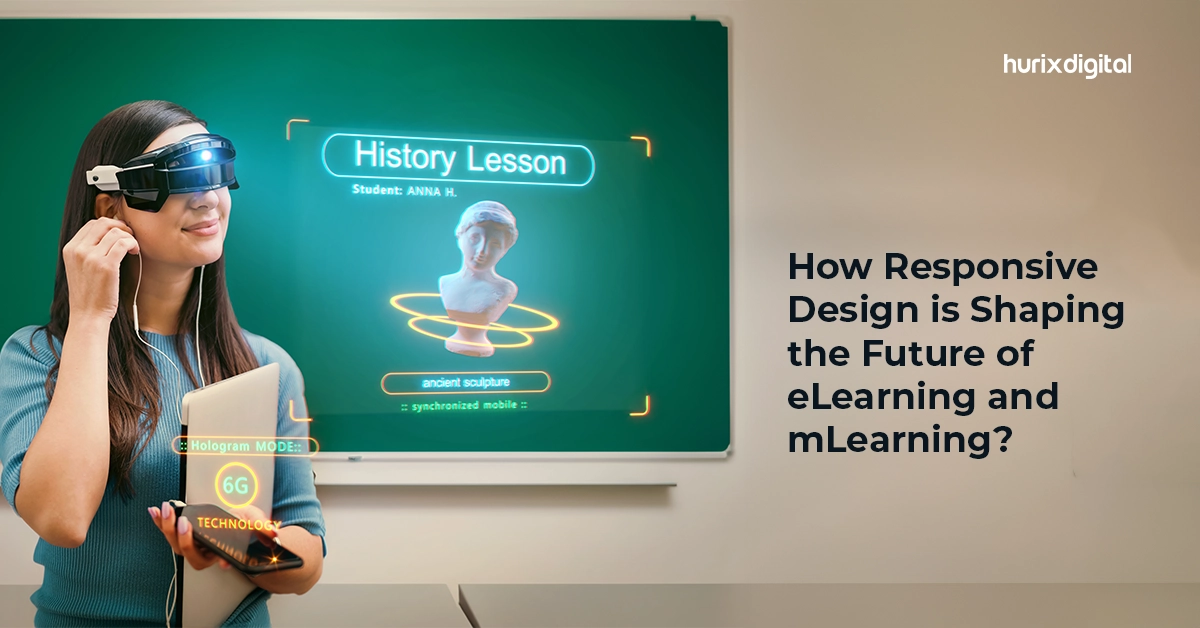
How Responsive Design is Shaping the Future of eLearning and mLearning?
Summary
This article discusses the importance of responsive design in eLearning and how it can be used to address the challenges of delivering eLearning across various devices and platforms.
Responsive eLearning refers to the design and development of online educational content that adapts and adjusts to different devices and screen sizes. The goal of responsive eLearning is to provide a seamless and optimal learning experience across a wide range of digital learning platforms, such as desktop computers, laptops, tablets, and smartphones.
Responsive eLearning is guided by two principles – fluidity and flexibility. Adaptation of responsive design in the content/courses can help us to address the challenges of delivering eLearning across various devices and platforms.
In this blog, we do a deep dive into responsive design and its many, many uses and implications.
Table of Contents
- Importance of Responsive eLearning
- How Does it Work?
- How is Responsive Design Revolutionizing the Future
- Conclusion
Importance of Responsive eLearning
In this digital world where devices are available in all sizes and shapes, it becomes extremely important to ensure that users get the best experience while learning on these devices. Today, users are constantly engaged on devices such as smartphones and tablets – browsing websites, shopping, social media, online learning, etc.
They also switch across devices multiple times a day depending on the need. Responsive design can give a smooth transition to the users from one screen size to another. Responsive eLearning design allows learners to efficiently complete their tasks and courses regardless of the device. Responsive design allows you to reach a broader audience giving them the freedom to choose whichever device they prefer for their learning needs.
Also Read: Inclusive Interface Design: Strategies for Engaging Every User with Empathy
How Does it Work?
Several authoring tools (built on HTML and CSS) are available in the market to develop responsive eLearning. This approach requires less development time and is cost-effective. In this method, responsive content automatically detects the screen size and optimally fits into the maximum space that the device provides. Hence, there is no need to create different versions of the same course/ content to function on different devices.
By making a single version of the responsive course /content we can achieve hassle-free distribution and work wonders on multiple devices without compromising on the user experience. To work effectively across various devices, responsive design in eLearning can be achieved by the following considerations:
1. Designing Flexible Layout
When using a wider screen device, the users can scroll to see more content and images horizontally. However, in smartphones and smaller screen devices, the content is stacked and rearranged, and images are arranged vertically.
2. Choose the Appropriate Font Type and Size
To ensure readability across devices, font type and size become very important. The font size may not look the same and can become pixelated on screens of different dimensions. Proper font type and size in responsive design will ensure optimal readability so users don’t need to squint their eyes.
3. Images/Graphics
Images such as PNGs and JPGs need to be scaled and resized to fit the different screen sizes. This could mean rearranging the images on the screen to give an optimal user experience.
4. Interaction and Navigation
The desktops/laptops include physical instruments such mouse and keyboard for interaction purposes whereas smartphones and mobile devices are touch-based devices. This becomes an important aspect considering the responsive design for interactivity elements such as buttons, hyperlinks, etc. while using touch-based screens or otherwise.
How is Responsive Design Revolutionizing the Future
Responsive design is shaping the future of eLearning and mLearning in several ways:
- Multi-device accessibility: Responsive design allows learners to access educational content seamlessly across different devices, including desktops, laptops, tablets, and smartphones. This flexibility accommodates learners’ preferences and lifestyles, ensuring that they can engage with the material anytime, anywhere, and on any device.
- Improved user experience: Responsive design focuses on creating an optimal user experience by adapting the content layout, navigation, and interactions to fit various screen sizes and resolutions. This approach eliminates the need for excessive scrolling, zooming, or panning, resulting in a smoother and more engaging learning experience.
- Personalized learning: Responsive design enables personalized learning experiences by leveraging the capabilities of different devices. For example, on a mobile device, learners may receive bite-sized content or microlearning modules suited for on-the-go learning. On larger screens, they may access interactive simulations or collaborative activities. By tailoring the content to each device, responsive design enhances learner engagement and knowledge retention.
- Adaptive content delivery: Responsive design allows content to adapt dynamically based on learners’ preferences, performance, and learning goals. By tracking user data and behavior, the system can customize the learning experience by recommending relevant content, providing targeted feedback, and adjusting the difficulty level of assessments. This adaptive approach enhances the effectiveness and efficiency of the learning process.
- Microlearning and mobile-first design: Responsive design aligns with the trend of microlearning, where educational content is delivered in bite-sized modules that are easily consumable on mobile devices. By focusing on mobile-first design principles, such as concise text, multimedia elements, and interactive features, responsive eLearning platforms cater to learners’ preferences for quick, accessible, and on-the-go learning experiences.
- Accessibility and inclusivity: Responsive design promotes accessibility and inclusivity by ensuring that eLearning content is available to learners with diverse needs and abilities. By supporting different devices and screen readers, responsive design makes educational materials more accessible to learners with visual impairments or other disabilities, creating an inclusive learning environment.
- Analytics and insights: Responsive eLearning platforms provide robust analytics and data tracking capabilities. By aggregating data from various devices, instructors and administrators gain valuable insights into learner behavior, engagement levels, and performance across different platforms. This data-driven approach continuously improves course design, delivery, and learner support.
- Scalability and cost-effectiveness: Responsive design offers a scalable solution for educational institutions and organizations. Instead of developing separate versions of courses for different devices, responsive design allows for the creation of a single course that can be accessed across multiple platforms. This approach reduces development costs and streamlines content updates, ensuring consistent learning experiences for a broader audience.
- Customizable Course Layout: Responsive design allows leveraging theme layouts for courses and customizing them as required. This enables easy and dynamic customization of layout blocks to enhance the look and feel of courses.
- Future Ready: By incorporating responsive design in eLearning, you can be future-ready with the courses and training resources. Since the courses are developed keeping in mind responsive design, it would not be a challenge to adapt them to devices of varying sizes that are waiting to be launched in the market.
- Better learning outcome: With responsive design in eLearning and mLearning, learner engagement is improved as it is convenient to access the learning content from any device. Learners can spend their time effectively learning using a device of their choice without having to worry about the intuitiveness and accessibility of the courses. This results in higher completion rates leading to better learning outcomes.
Also Read: How to Design Responsive eLearning Courses Using Authoring Tools?
Conclusion
By embracing responsive design principles, eLearning and mLearning are evolving to meet the needs and expectations of modern learners. The future of digital education lies in delivering personalized, accessible, and engaging learning experiences across a range of devices, and responsive design is at the forefront of this transformation.
Organizations are now putting more emphasis on designing responsive eLearning solutions for their customers given the virtual and remotely connected world that we live in. Well-designed responsive content for eLearning is the need of the hour and will require a one-time investment of time for development and testing. This will make the course/content future-ready and fetch better results in the long run.
You can employ the services of an expert like Hurix Digital to help you step into the future of learning!
Book a 15 minutes discovery call to know more about future of eLearning & mLearning.

SVP & Head – Hurix Technology Solutions
Global Delivery head with 25 years of working experience in NYC investment banks and fintech companies. Hands-on technology delivery management and program management, accountable for stakeholder relationships, Strategic roadmap, P&L, Revenue growth, Account Management, and employee satisfaction.








